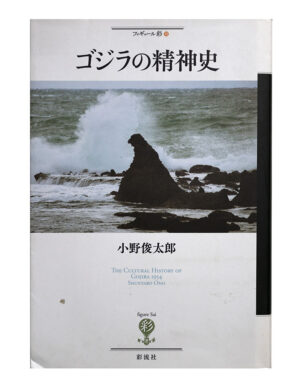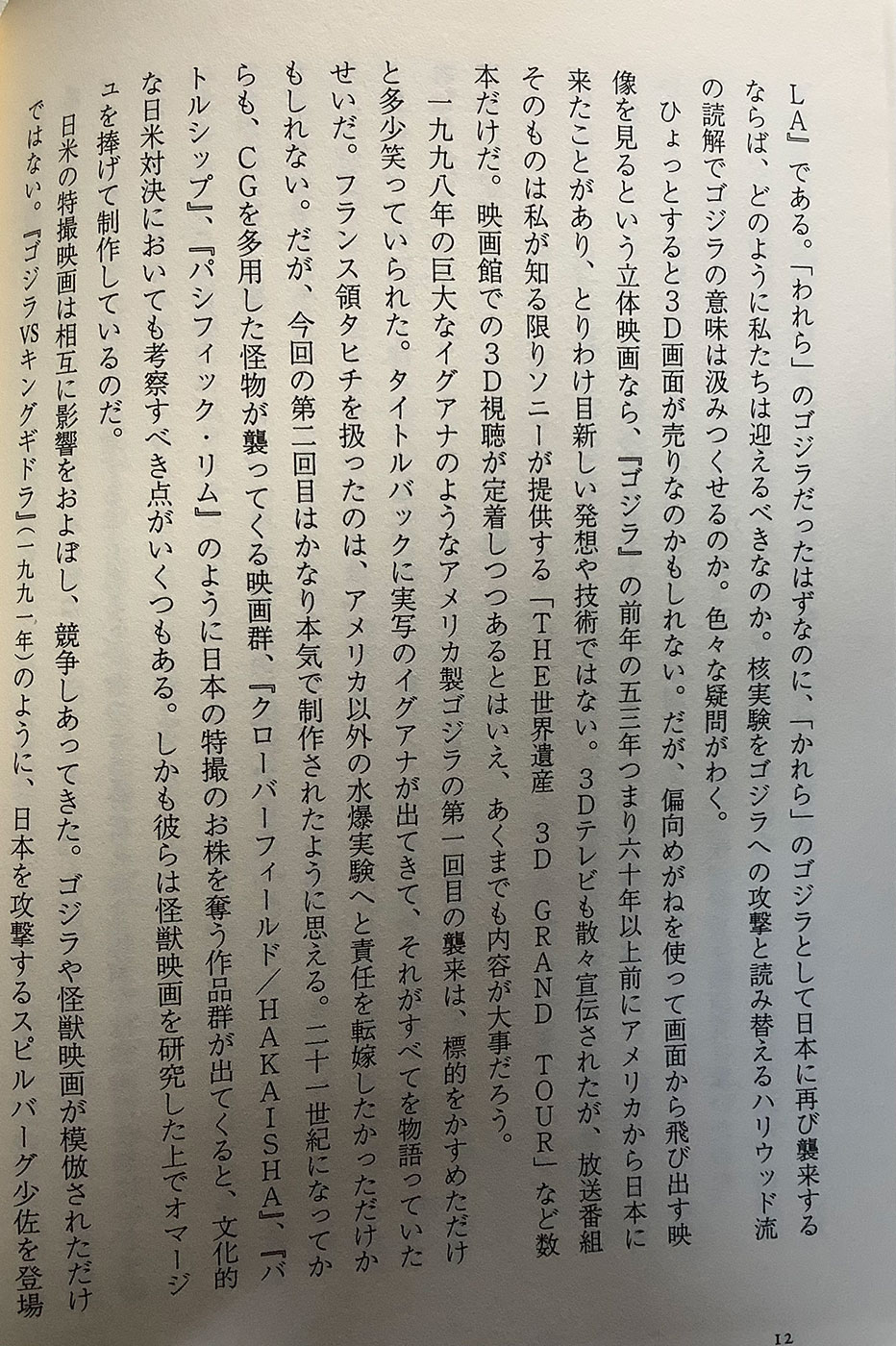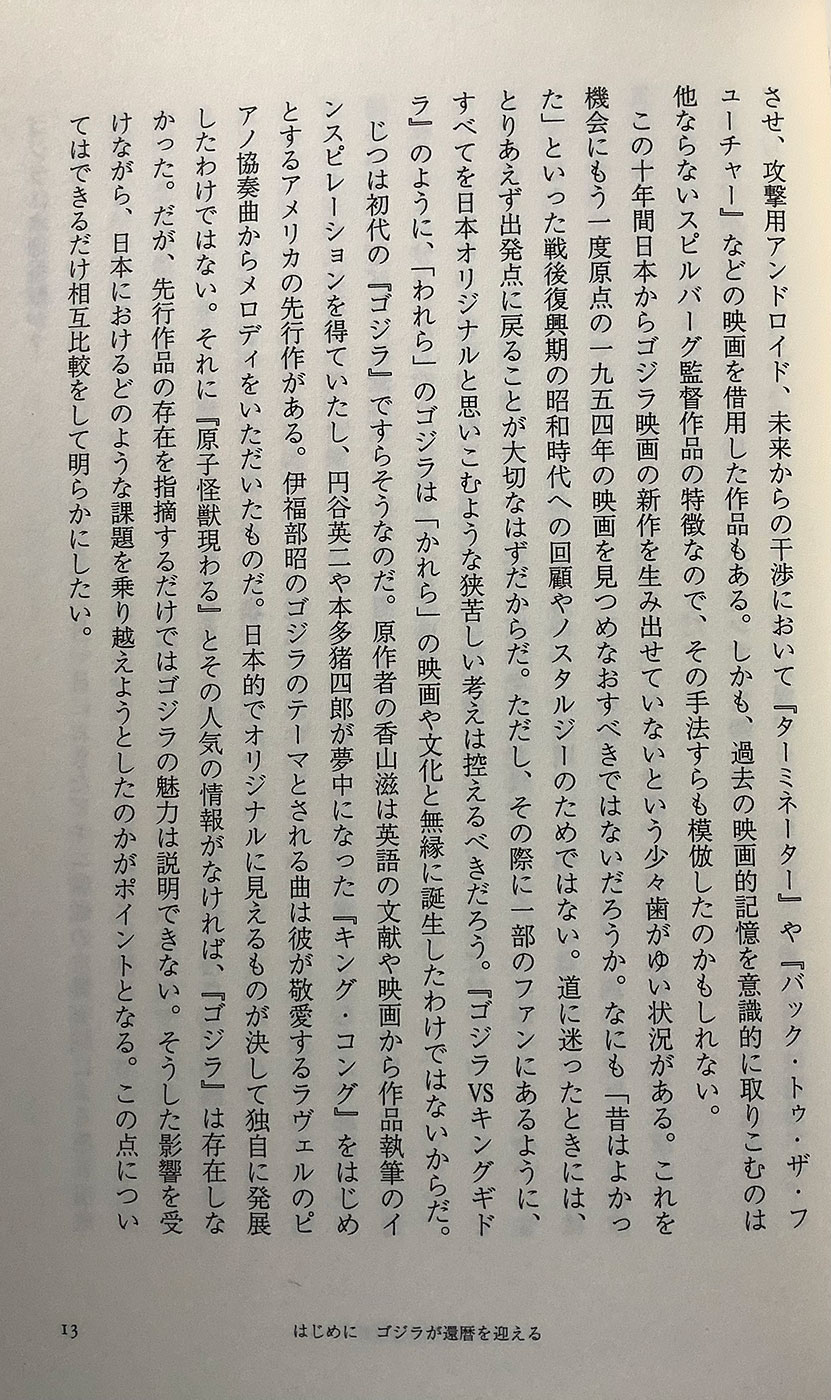9.8.2022
The Cultural History of Godzilla – Pt 4


P 12
では、議論がこれほどグローバルに広がる状況なのに、あえてゴジラ論を書く理由は何か。動機となったのは、二〇一四年というゴジラ還暦の年にぶつけて制作された、ハリウッド版「GODZILLA」である。「われら」のゴジラだったはずなのに、「かれら」のゴジラとして日本に再び襲来するならば、どのように私たちは迎えるべきなのか。核実験をゴジラへの攻撃と読み替えるハリウッド流の読解でゴジラの意味は汲みつくせるのか。色々な疑問がわく。
So, what is the reason for writing a Godzilla theory even though the discussion is so global? The motivation was the Hollywood version of “GODZILLA,” which was produced in 2014, the year of Godzilla’s 60th birthday. It should have been “our” Godzilla, but if it were to attack Japan again as “their” Godzilla, how should we welcome it? Is it possible to understand the meaning of Godzilla in Hollywood-style reading, which replaces the nuclear test with an attack on Godzilla? I have many questions.
ひょっとすると3D画面が売りなのかもしれない。だが、偏向めがねを使って画面から飛び出す映像を見るという立体映画なら、「ゴジラ」の前年の五三年つまり六十年以上前にアメリカから日本に来たことがあり、とりわけ目新しい発想や技術ではない。3Dテレビも散々宣伝されたが、放送番組そのものは私が知る限りソニーが提供する「THE世界遺産 3D GRAND TOUR」など数本だけだ。映画館での3D視聴が定着しつつあるとはいえ、あくまでも内容が大事だろう。
Perhaps the 3D screen is the selling point. However, in the case of stereoscopic movies where you use polarized glasses to see images popping out of the screen, it came to Japan from the United States more than 60 years ago, in 1953, the year before “Godzilla,” and I was particularly impressed with the new ideas and techniques. 3D TV was also heavily advertised, but as far as I know, there are only a few broadcast programs such as “The World Heritage 3D GRAND TOUR” provided by Sony. Although 3D viewing in movie theaters is becoming established, the content is still important.
一九九八年の巨大なイグアナのようなアメリカ製ゴジラの第一回目の襲来は、標的をかすめただけ と多少笑っていられた。タイトルバックに実写のイグアナが出てきて、それがすべてを物語っていた せいだ。フランス領タヒチを扱ったのは、アメリカ以外の水爆実験へと責任を転嫁したかっただけか もしれない。だが、今回の第二回目はかなり本気で制作されたように思える。二十一世紀になってか らも、CGを多用した怪物が襲ってくる映画群、「クローバーフィールド/HAKAISHA」、「バ トルシップ』、『パシフィック・リム』のように日本の特撮のお株を奪う作品群が出てくると、文化的 日米対決においても考察すべき点がいくつもある。しかも彼らは怪獣映画を研究した上でオマージ ュを捧げて制作しているのだ。
The first attack of the giant iguana-like American Godzilla in 1998 was somewhat laughable as it just skimmed the target. It was his fault that a live-action iguana appeared in the title background and that said it all. He may have dealt with French Tahiti simply because he wanted to shift the responsibility to other countries than the United States for testing hydrogen bombs. However, this second edition seems to have been produced quite seriously. Even in the 21st century, Japanese special effects stocks such as “Cloverfield / HAKAISHA,” “Battleship,” and “Pacific Rim,” movies that use CG extensively to attack monsters, are still popular. When a group of works to steal comes out, there are many points to consider in the cultural confrontation between Japan and the United States.

P 13
日米の特撮映画は相互に影響をおよぼし、競争しあってきた。ゴジラや怪獣映画が模倣されただけ ではない。「ゴジラ キングギドラ』(一九九一年)のように、日本を攻撃するスピルバーグ少佐を登場させ、攻撃用アンドロイド、未来からの干渉において『ターミネーター』や『バック・トゥ・ザ・フ ューチャー』などの映画を借用した作品もある。しかも、過去の映画的記憶を意識的に取りこむのは 他ならないスピルバーグ監督作品の特徴なので、その手法すらも模倣したのかもしれない。
Japanese and American tokusatsu films have influenced and competed with each other. It’s not just that Godzilla and monster movies are imitated. Like “Godzilla King Ghidorah” (1991), Major Spielberg who attacks Japan appears, attacking androids, interference from the future, such as “Terminator” and “Back to the Future.” There are also works that borrow from movies, and since Spielberg’s works are characterized by consciously incorporating memories of the past, he may have even imitated that technique.
この十年間日本からゴジラ映画の新作を生み出せていないという少々歯がゆい状況がある。これを機会にもう一度原点の一九五四年の映画を見つめなおすべきではないだろうか。なにも「昔はよかっ た」といった戦後復興期の昭和時代への回顧やノスタルジーのためではない。道に迷ったときには、とりあえず出発点に戻ることが大切なはずだからだ。ただし、その際に一部のファンにあるように、すべてを日本オリジナルと思いこむような狭苦しい考えは控えるべきだろう。『ゴジラ キングギドラ」のように、「われら」のゴジラは「かれら」の映画や文化と無縁に誕生したわけではないからだ。
It’s a bit frustrating that Japan hasn’t been able to produce a new Godzilla movie for the past ten years. Shouldn’t we take this opportunity to reconsider the 1954 film that was the starting point? It is not for retrospection or nostalgia for the Showa era, the post-war recovery period, such as “the old days were good.” This is because it should be important to return to the starting point for the time being when you get lost. However, at that time, as some fans say, we should refrain from narrow-minded thinking that everything is Japanese original. Like “Godzilla King Ghidorah,” “our” Godzilla was not born without “their” movies and culture.
じつは初代の『ゴジラ』ですらそうなのだ。原作者の香山滋は英語の文献や映画から作品執筆のインスピレーションを得ていたし、円谷英二や本多猪四郎が夢中になった『キング・コング』をはじめとするアメリカの先行作がある。伊福部昭のゴジラのテーマとされる曲は彼が敬愛するラヴェルのピアノ協奏曲からメロディをいただいたものだ。日本的でオリジナルに見えるものが決して独自に発展 したわけではない。それに「原子怪獣現わる』とその人気の情報がなければ、「ゴジラ」は存在しなかった。だが、先行作品の存在を指摘するだけではゴジラの魅力は説明できない。そうした影響を受けながら、日本におけるどのような課題を乗り越えようとしたのかがポイントとなる。この点についてはできるだけ相互比較をして明らかにしたい。
In fact, even the original “Godzilla” is like that. The original author, Shigeru Kayama, was inspired to write his works from English literature and movies, and there are American precedents such as King Kong, which Eiji Tsuburaya and Ishiro Honda were obsessed with. The theme of Akira Ifukube’s Godzilla is a melody taken from Ravel’s piano concerto, which he admires. What appears to be Japanese and original has never developed independently. In addition, without “Atomic Monster Appears” and its popularity information, “Godzilla” would not have existed. However, the appeal of Godzilla cannot be explained simply by pointing out the existence of previous works. The point is what kind of challenges Japan tried to overcome while receiving such influences. I would like to clarify this point by making mutual comparisons as much as possible.